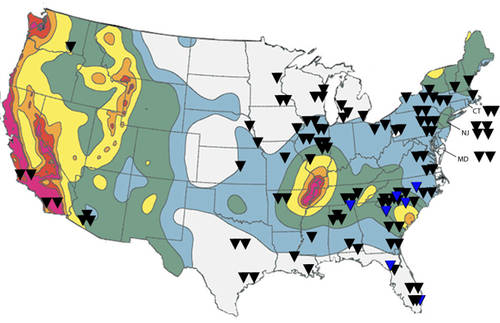US Stores Spent Nuclear Fuel Rods At 4 Times Pool Capacity
By Rady Ananda
27 March, 2011
Countercurrents.org
In a recent interview with The Real News Network , Robert Alvarez, a nuclear policy specialist since 1975, reports that spent nuclear fuel in the United States comprises the largest concentration of radioactivity on the planet: 71,000 metric tons. Worse, since the Yucca Mountain waste repository has been scrapped due to its proximity to active faults , the US Nuclear Regulatory Commission has allowed reactor operators to store four times more waste in the spent fuel pools than they're designed to handle.
Each Fukushima spent fuel pool holds about 100 metric tons, he says, while each US pool holds from 500-700 metric tons. A single pool fire would release catastrophic amounts of radioactivity, rendering 17-22,000 square miles of area uninhabitable. That's about the size of New Hampshire and Vermont – from one pool fire.
In a March 25 th interview , physician and nuclear activist Dr Helen Caldicott explains that “there's far more radiation in each of the cooling pools than there is in each reactor itself…. Now the very short-lived isotopes have decayed away to nothing. But the long-lived ones, the very dangerous ones, Cesium, Strontium, Uranium, Plutonium, Americium, Curium, Neptunium, I mean really dangerous ones, the long-lived ones – that's what the fuel pools hold.”
As a Senior Scholar at the Institute for Policy Studies , Alvarez was part of a multidisciplinary international team that looked at possible terror attacks on nuclear facilities, focusing on the spent fuel storage pools. In 2003, they released a report, Reducing the Hazards from Stored Spent Power-Reactor Fuel in the United States , which calls for transferring the spent fuel from the pools into dry-cask storage. (Summary here .)
The report recommends that 75% of the spent rods be removed from each of the pools and stored in ultra-thick concrete bunkers capable of withstanding aerial impact. The project would take about ten years and would “reduce the average inventory of 137Cs (radioactive cesium) in U.S. spent-fuel pools by about a factor of four.”
The NRC attempted to suppress the IPC report, Alvarez says. “The response by the Nuclear Regulatory Commission and nuclear industry was hostile.” But the National Academy of Sciences agreed that a fire in an overloaded fuel pool would be catastrophic. The NRC attempted to block the Academy's report, as well.
The NRC serves industry, not the public, and by controlling the purse strings, Congress has forced the NRC to “greatly curtail its regulatory programs,” says Alvarez.
Engineer Keith Harmon Snow couldn't agree more. He recently lambasted the NRC and mainstream media for downplaying the ongoing catastrophe in Japan. He notes that, “The atomic bomb that exploded at Hiroshima created about 2000 curies of radioactivity. The spent fuel pools at Vermont Yankee Nuclear Plant (U.S.) are said to hold about 75 million curies .” [emphasis added]
And that's just one US nuclear plant, out of 104, not to ignore the undisclosed number of research sites. Then consider that several nuclear plants sit on geologic faults , as this image by Public Integrity reveals:

Also see this global map of earthquake activity and nuclear power plant locations.
Nuclear waste is a serious, deadly and growing problem that the industry refuses to address, preferring to externalize disposal costs onto the public (even suing the US government to clean up its mess for them, under a 1998 law it no doubt favored).
Unless the radioactive waste is laser-launched toward the sun, we're stuck with waste that will contaminate the biosphere for thousands of years, for the measly prize of 25-30 years of electricity, as nuclear activist and mathematician Gordon Edwards so eloquently explained . The risk far outweighs the benefit; this energy choice exemplifies the insanity of the nuclear industry and its government protectors.
Further Sources:
Chernobyl: Consequences of the Catastrophe for People and the Environment , by Alexey V. Yablokov and Vassily B. Nesterenko and Alexey V. Nesterenko (English publication: 2009), recently reviewed by toxicologist Janette Sherman on BlipTV, and also reviewed last year by Professor Karl Grossman at Global Research.
Nuclear Reactors in Earthquake Zones around the Globe (TreeHugger, compiling various sources)
US Radiation Monitoring Map in Real Time (Radiation Network)
Video Maps Spread of Radioactivity in Real Time (Central Institute for Meteorology and Geodynamics, Austria)
Recent articles by Robert Alvarez:
Unsafe at Any Reactor : March 23, 2011
Safeguarding Spent Fuel Pools in the United States : March 21, 2011
The Drained Spent-Fuel Pool at Unit 4 : March 16, 2011
Comments are not moderated. Please be responsible and civil in your postings and stay within the topic discussed in the article too. If you find inappropriate comments, just Flag (Report) them and they will move into moderation que.


